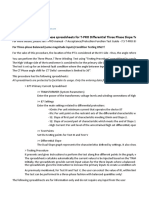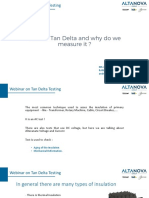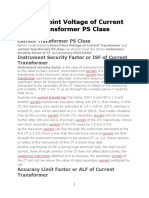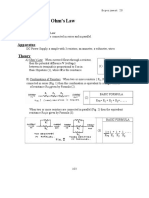Current Transformer Testing
Uploaded by
Venkat CherukuriCurrent Transformer Testing
Uploaded by
Venkat CherukuriA METHOD FOR TESTING CURRENT TRANSFORMERS
By
Francis B. Silsbee
CONTENTS
Page
t
Introduction
317
General principles Null method
Deflection
318 321 325
3
method
Experimental results
28
Summary
328
INTRODUCTION
Several precise laboratory methods are now available for the determination of the ratio and phase angle of current transformers. 1 These, however, all require a considerable amount of special
apparatus, such as carefully calibrated noninductive shunts and very sensitive alternating-current detectors, and are therefore not suited for use under shop or central-station conditions. The task of comparing the constants of one transformer with those of a second transformer taken as a standard is much less difficult. The standard transformer should, of course, have the same nominal ratio, and its constants should have been determined by one of the precise laboratory methods. A method for such a comparison of two voltage transformers has been published by Brooks, 2 and another method applicable to either
voltage or current transformers
The method developed in the first of these and will
second.
by Agnew 3 and by Knopp. 4 this paper is somewhat analogous to be found rather more rapid than the
As
in the other
less sensitive
1
comparison methods the detector may be much than in the absolute methods, and it is therefore
Agnew and
30, p. 435, 466, 1909; E. T.
Fitch, this Bulletin, 6, p. 281, 1909; Electrical World, 54, p. 1042, 1909; E. Orlich, E. T. Z., Robinson, Trans. Am. Inst. Elec. Eng., 28, p. 1005, 1909; F. A. Laws, Electrical
World, 55,
p. 223, 1910;
Sharp and Crawford, Trans. Am.
Inst. Elec. Eng., 29, p. 1517, 1910;
Silsbee, Trans.
2, p. 263, 1914.
2
3 4
Am.
Inst. Elec. Eng., 31, p. 1635, 1912; Schering
and
Alberti,
Agnew and Archiv fur Elcktroteclmik,
62, p. 898, 19x3.
H. B. Brooks, this Bulletin, 10, p. 419, 1914 (Scientific Paper No. 217); Electrical World, P. G. Agnew, this Bulletin, 11, p. 347, 1914 (Scientific Paper No. 233). O. A. Knopp, Electrical World, 67, p. 92, 1916.
317
3i8
Bulletin of the
Bureau
of
Standards
[Vol. 14
possible to use a
more rugged type
they
of instrument, such as a
com-
mercial wattmeter.
useful
Multiple-range transformers are particularly
show practically proportional ratios and identical phase angles on the various primary connections. Two or three such transformers, the ratio and phase angle of which have been accurately determined, suffice for testing
as
standards, since
a considerable range of transformers.
GENERAL PRINCIPLES
method is illustrated by Fig. i 5 and and the unknown transformer, respectively. The primary windings are connected in series and supplied with current from a suitable source. The secondary windings are also
The
principle of the
are the standard
Fig.
connected in series, with such polarity that both tend to send current in the same direction, and any desired impedance loads such as zs and z x complete the circuit. A suitable detector D is
then connected so as to bridge across between the transformers. It is evident that the current AI through the detector (which we shall assume for the present to have a negligible impedance) is necessarily equal to the vector difference of the secondary currents Consequently, if the magnitude I s and / x of the transformers. and phase of AI are measured, the difference in performance of the two transformers can be computed. This measurement of AI may be made either directly by using as a detector one winding of a separately excited wattmeter, as is described below as the "Deflection method," or the measurement may be made indirectly by using an additional compensating circuit between .4 and B, as indicated by the dotted lines. By proper arrange-
ment
of the
impedances
all
of
AI may be made to flow
in this
susbee]
Testing Current Transformers
319
compensating circuit, and the current in the detector reduced to zero. This is described below as the "Null method." There are, of course, a great many other possible arrangements for measuring AI, but the two here described in detail will be found the most
convenient.
siderable extent
The performance of a current transformer depends to a conupon the impedance of the apparatus and wiring
circuit.
connected in the secondary
to determine
It is therefore of
what impedance is introduced into the circuit transformer by the arrangement of circuits shown in Fig. 1
transformer
importance of each
.
carrying a current I x at a terminal voltage Ex, and the equivalent impedance load is
is
Now
= 7- =
^x
f ^s
= z x j^x
(vectonally)
In the deflection method
of the detector)
is
Ed
(the voltage
between the terminals
E d = AIz d
And
hence
Z x = z x z d-f
* X
(vectorially)
and
similarly
Z = z + z d ~y~
s s
(vectorially)
It is therefore
evident that
is
when the secondary
currents are
nearly equal, so that -y-
very small, a detector of considerable
sensitivity
impedance and therefore of high-current
may
be used.
On
the other hand,
when
-j
is
large,
then the use of a detector of
may shift the load from the transformer of higher having the lower and thus make the difference in ratio appreciably less than the correct value. In the null method, on the other hand, E d is zero when a balance
high impedance
ratio to that
is
reached, so that
79 ^X ^X
of each transformer
is
and the performance
the same as
if
the
by a short-circuiting link across Although very evident theoretically, this fact was also tested experimentally, and the behavior of the transformer was found to be the same as when the detector was replaced by a
other transformer were replaced
C.
wire of negligible resistance.
320
Bulletin oj the
Bureau
oj
Standards
\Voi.i4
The principal limitation on the sensitivity attainable in any method of testing current transformers is due to the condition that the measuring circuit must not affect the performance of the transformer. This means that the measuring apparatus must not increase the equivalent connected secondary load by more than a certain resistance which we may denote by r. The gain in sensitivity of a comparison method, such as is described in this paper over an absolute method, is seen by comparing the power available for operating the detector in the two cases. In the usual absolute method the secondary current / is passed
through a noninductive resistance which is preferably equal to r. Ir is balanced by the drop due to the primary current flowing through a proportionately smaller resistance. With such an arrangement the impedance of the circuit external to the detector is approximately r, and for the maximum sensitivity the detector itself should also have this same impedance. If under these conditions the secondary current should differ by a small amount 81 from that required for an exact balance, then the unbalanced voltage acting in the detector circuit will be only blr. Since the resistance of the complete circuit is 2r, the current flow-
The voltage drop
big in the detector will be
and the voltage across the detector
will
be
X T
Consequently the power available
2 is
5 T
r.
On
the other hand, in the case of the deflection method outlined
in this paper,
the total difference AI between the two secondary
its
currents flows through the detector and produces a voltage at
terminals equal to AIz d
Here
z d is the
and
is
limited
by the
fact that this
impedance of the detector, voltage AIz d must not exceed
A/.
the permissible value Ir for the
quently,
largest value of
Conse-
we have
z &<iri Y
and
if
we use
a detector having this im-
pedance, the volt amperes available for a difference hi in the currents
is
_2 / 5/ ~Zjr.
Since the two transformers will usually differ by
-rj is fairly large
only a few per cent the factor
required
and the detector
50 or 100 times less sensitive than in the precise laboratory methods. It is this relation which brings the method within the range of sensitivity obtainable with commercial pivoted
instruments.
may be
susbee\
Testing Current Transformers
321
NULL METHOD
of null
The connections of what is probably the most satisfactory form method based on the general arrangement outlined above
2.
ABCD is a slide wire of about 0.2 ohm total a mutual inductance of about 600 microhenry s, the primary of which can carry 5 amperes without excessive r is a resistance of about 30 ohms, preferably capable heating. of being set at several other values down to 2 ohms. As the value of r t appears in the denominator in the equations below it is convenient to have the total resistance between F and C, including the resistance of the secondary winding of M, an exact integer M, r t and r2 need be calibrated only to the for each setting of r v per cent accuracy which is desired in the difference of the ratios; that is, to about 1 per cent. The detector shown in the figure is a separately excited electrodynamometer instrument. A commercial wattmeter of lowcurrent range may be adapted for this work by bringing out taps directly from the moving coil without using any of the series The moving coil is connected as shown and the curresistance. rent coil excited by its full rated current in either of two phases, which preferably are in quadrature, through the double-throw switch G. Any other form of alternating-current detector sensitive to 0.00005 ampere might be used. 5 As a precaution a 10-ampere ammeter should be connected in parallel with the detector, so that the transformers will not be damaged if they have inadvertently been connected in opposition instead of aiding. If on closing the circuit this ammeter shows
are given in Fig.
resistance.
is
no appreciable current the polarity of the transformers and the ammeter should then be disconnected.
is
correct,
The procedure is to adjust the position of the slider C and the value of the mutual inductance until no deflection is obtained on closing G in either direction. When a balance is thus obtained
all
of the differential current
A/
is
flowing through r 1} and also
the difference of potential between points
sequently, the voltage drops between
and
F is
zero.
Con-
C and F and
between
and
one another. From this relation the differences in the ratios and phase angles of the two transformers may be computed.
must be equal and
in phase with
for this
A new type of vibration galvanometer has been recently developed by Agnew which is very well suited work. A description of this sensitive yet rugged instrument is to be published shortly in this
Bulletin.
322
If
Bulletin oj the
Bureau
of
Standards
\v0i.j4
and R x are the ratios of the transformers 5 and X, respectively, and <x B and a x are the corresponding phase angles, then we have 6 for the case where the slider C is to the right of B (Fig. 2)
a
R
and
6
tan (a x
- a8) = 6 + ac
as follows:
The equations Riven below may be deduced
For the connections as drawn in Fig.
we have
and
A/=/-/ x
A!(.ri+juLi)+hu.\f=/ x r-:
laws,
(i)
(2)
by KirchhofT 's
where the currents are to be regarded
as vector quantities.
Hence, eliminating A/, we get
lAn+MLi + M}=U(n~r:+^Li)
T%
(3)
U
n
r= -^
T\
'
V n
,
Substituting
,
=
l
-"
/,
= ^^
T\
Tl
= l?pin
+ a -bc-V...+j{-b-ac-ob....)
(5)
This quotient must
formers.
7P
.
now be determined
But
since
The
ratio of a current transformer
to that of the secondary.
we
A
terms of the current ratios and phase angles of the two transis simply the ratio of the magnitude of the primary current, are now regarding the currents as vector quantities, we must
as )
(6)
write for the ratios
R = ^(cos cti+j sin
i?i=-p (cos a x +>sin a x )
ix
(7)
where the complex factors in the parentheses have been introduced to make the ratios themselves (#, and Rx) simple numbers instead of vector quantities. (The complex factor in each case merely turns the vector I p through the angle a, into coincidence with the secondary current.) It is to be noted that this assumes that the phase angle, a, is positive when the reversed secondary current leads the primary current. From (6) and (7) we have
R x (cos <zs+j sin _/g R (cos ai +> sin a x )~I x
tt s )
(8)
Of rationalizing
^|cos(a 9 -a)+y
sm(aa-*)}=^
get
(9)
Equating
(5)
and
(9)
and separating the
-
real
and imaginary terms, we
x )=i
*cos(a
Ra
+ a be
2
.
(11)
and
Ra
p >sina( x)=-b ac ab.
g
..
(12)
Solving these equations simultaneously,
we have
l/5
^
and
which are the formulas
= {(i+a-&c-62)2+(_6_ at o6)*} -i + fl-^.-6c
tan(** <r,)=*6+a
(13)
(14)
desired.
The deduction
for the case
when the
slide
is
to the
left of
(Fig. 2)
is
similar to the
above with
slight
differences in the second-order terms.
Silsbee]
Testing Current Transformers
323
as transformer
For the case where
then
is
on the same side of
X,
^=
tan (a x
-
a 4- a
be
-a )
s
=^b
ac ab
ajL t
where
^2
^1
and
oj=27tX frequency.
fi
= the
total resistance
between
C and
through
rt
and
(Fig. 2), in
ohms.
= the L = the
r2
x
resistance of the slide wire between
B and C, in ohms.
self -inductance of the secondary coil of the mutual inductance M, in henrys. = the value of the mutual inductance, in henrys. (This is to be taken as positive if a x is greater than a 9 as shown by the test described below.)
Ammeter
fhoaell
L*
&h>a&el
Fig. 2
324.
Bulletin of the
Bureau
of
Standards
[Vd. i 4
The second-order terms are usually very small and to an accuracy of a tenth per cent we have in either case
R* = Ra (i a) x = a* + 3438 b
if
the angles are expressed in minutes.
If
is obtained with the slider between B and D then (provided the second-order terms are less than a), the standard transformer is supplying the greater secondary current and consequently has the smaller ratio. The question which secondary current leads the primary current by the greater angle can best be determined once for all by adding some resistance This will always make 7 X lead to the load on transformer X. more than before and if the value of required for a balance is increased then I x was leading originally and and b are to be taken as positive with this connection of the mutual inductance. In the case when the slider C is to the right of B (Fig. 2) and the part A B of the slide wire is omitted, then the measuring circuits introduce no impedance whatever into the equivalent secondary circuit of transformer X. It is therefore possible by this arrangement to test a current transformer under the condition of zero external load. The load on transformer 5 or, in case C is to the left of B, on both transformers, is practically the same as the impedance of the slide wire and the primary winding of M. The slight change in this, due to the fact that r, in effect shunts r 2 is of the order ar 2 and its effect on the performance of either
the balance
(Fig. 2),
transformer
slider
is
entirely negligible.
It is evident that
of
if 5 always had a smaller ratio than the would always be on the standard side of B and the part AB the slide wire would be unnecessary. This arrangement is very
resistance of
away with the necessity of allowing for the making the total impedance load on transformer equal to the desired value. The ratio of the standard transformer could be reduced by omitting a few turns from the
desirable since
it
does
in
AB
secondary winding in the process of manufacture. In completed transformers of the hole type this can still be done by passing a few secondary turns through the hole in a direction to oppose the main secondary winding. Since at the point of balance no current flows through the moving coil of the detector the self -inductance of this coil has no The mutual inductance between the two effect on the results.
Silsbee]
Testing Current Transformers
325
coils of
the wattmeter, however, does produce an electromotive
F even when no current flows and This source of error can easily be eliminated by shifting the position of the control springs so that the normal zero of the instrument corresponds to the position of
force
between the points
and
therefore affects the setting.
zero mutual inductance. 7
If
the current in Phase I of the exciting circuit
is
in phase with
the current in the transformers and Phase II is 90 from this, then the slider C may be adjusted with G closed to the right, with G to the left, and the two settings will be independand It is not at all necessary, however, that these ent of each other. phase relations be exact and Phase II may be 6o from Phase I,
s-fv
1mm a
Load
i5pr^
PV
Am.
C^D
W7?.
I//TX
QBSl
haseX fi
I
Fig.
PMsel
a polyphase supply is not available, current for Phase I may be drawn through a lamp bank and Phase II from the same supply through a reactance coil or transformer winding. With this arrangement it is well not to work the iron of the core much above its normal rating or the harmonics in the
If
as in a 3-phase system.
exciting current will
become
excessive.
DEFLECTION METHOD
In cases where a variable mutual inductance and slide wire
are not available, but a polyphase supply
tion
7
is
at hand, the deflecin Fig. 3)
still
method
(the connections for
which are shown
coil (or
may
it
This position can be determined by short-circuiting the moving;
better
by connecting
full
to a large inductance of low resistance, such as the 220-volt winding of a transformer)
and passing
rated
current through the fixed coil. Under these conditions the pointer deflects toward the position of sero mutual inductance, and by suitably moving the control springs the desired position can soon be located. An alternative method is to connect a telephone receiver to the moving coil and pass full-rated current through the fixed coil. The springs can then be adjusted until no sound is heard in the telephone.
59467 18
11
326
Bulletin 0} the
Bureau
of
Standards
iva.14
The detector in this method must be of the dynamometer type, and arranged so that one coil may be supplied from two circuits, one giving a current in phase with the current in the transformers and the other giving a current having a known
be used.
phase relation, preferably quadrature with the former. If Di and D q are the deflections in divisions, observed with the excitation in phase, and in quadrature, respectively, we have
R x=
R*
tan (a x <x 3 )
KDj
^3
K D3
approximately,
where
If
is
the wattmeter
coil,
the constant of the instrument in amperes per division. is excited by passing a current I through its curk K = IqRv
rent
where k is the constant and R Y is the resistance
If
in
watts per division for a given range
of the voltage circuit of the
same range.
the
w attmeter
r
is
excited
by applying a voltage
EQ to the voltage
circuit,
then
In case the second phase available as a source of excitation is not in quadrature with the first, but gives exciting current which lags behind the current in the transformers by an angle 6 and produces a corresponding deflection D d) then we have
R*_
R*~
, tan (,-,)
,
J+
,
KD
h
= K f PeDi
J7
(-^
cos 6 \
As before, the question which secondary current is the greater and which leads the primary current by a greater angle can best be answered by changing the load on one transformer and noting the effect on the deflections, remembering that an increase in secondary resistance makes the secondary current smaller and also makes it lead the primary current more.
Stisbee]
Testing Current Transformers
327
The principal limitation of this method is, as mentioned above, the effect of the impedance of the detector in shifting the load from one transformer to the other. The change in the equivalent
impedance load on either transformer due to
this is given
by
AI ZdK'ylDi y - zd AZ j j
Since this varies with the deflection
for this
+D
2
<l
it is
impracticable to allow
impedance in arranging the secondary loads on the transformers and it is necessary to reduce AZ not to a comparatively small and definite value, as in the null method, but to a value which can be entirely neglected. If the moving coil of a commercial wattmeter is used as a detector, it must therefore be shunted by a rather low resistance and the sensitivity correspondingly reduced. The current circuit of a 1 -ampere wattmeter has about the desired impedance and will be found satisfactory as a detector
for this work.
is
The use
of the voltage circuit for the excitation
it
also convenient, since
avoids the necessity of a separate
coils also
if
resistance.
The mutual inductance between the
scale
introduces an
equivalent load on the transformers, but
over the part of the
used the
coil is
reasonably near the position of zero mutual
inductance, this error will be less than that due to the impedance.
As a
specific
example of the various factors entering into the
choice of a detector, let us consider the commercial wattmeter
used in the experiments described below, which has the following constants
Nominal current
2.
Maximum Maximum
current
voltage
3.
amperes. amperes.
volts.
volts.
Nominal voltage
Resistance of fixed coil
75.
no.
o.
27
ohm.
Resistance of moving coil Resistance of voltage circuit
1,
42.
178.
ohms. ohms.
Watts per division
.5
When
circuit
this instrument is used with excitation
on the voltage
we have
K=
2d
= 4.5 X
io~ 3 amperes per division,
=o.27 ohm, approximately.
Bulletin oj the
Bureau
of
Standards
[Voi.i 4
When
coil
used with excitation on the current circuit the
resistance of about
i
mo v
must be shunted to give a
ohm
so that
K = X
3
1
178
= 6.0 X io
i
per amperes r r
division,
zd
ohm, approximately.
1
If
the two transformers differ by
per cent in current, then at
deflection
the 5-ampere point
and
in
we have in the first case the D = 8.3 divisions AZ = 0.003 ohm,
the second case
D=
and
1 1
divisions
AZ = o.oi ohm.
further error arises
if
the exciting voltages are not in the
of this effect varies greatly with
If this dif-
correct phase.
The magnitude
the difference in constants of the two transformers.
ference
shift in
is 1 per cent in ratio and 30 minutes in phase angle, a phase of 7 degrees in the exciting voltage will produce an error of about 0.1 per cent in ratio and 3 minutes in angle. An auxiliary 5-ampere wattmeter connected as shown at in Fig. 3 is a convenient means of determining these phase relations.
Wm
EXPERIMENTAL RESULTS
methods described above have been tried experimentally and the results are plotted on a large scale in Fig. 4. Curves .4 and B give the ratio factor and phase angle, respecof the
Both
a 2 5 -ampere, 40 volt-ampere portable current transformer at 60 cycles. The curve is drawn through values obtained by a precise laboratory method. The crosses are points observed by the null method using as a standard a similar transformer carrying considerably less load. Curves C and D give the ratio factor and phase angle of another transformer which was tested by the deflection method. As before, the curves are drawn through the points obtained by a precise laboratory method and the circles show the values obtained by the method here proposed.
tively, of
SUMMARY
general
method has been outlined
for the determination of
the ratio and phase angle of current transformers in terms of the
constants of previously calibrated standard transformers of the
Stlsbee]
Testing Current Transformers
329
same nominal ratio. It has been shown that such methods are more sensitive, or conversely may be used with much less sensitive instruments, than the laboratory methods now in use for the absolute determination of the ratio and phase angle Two of the most convenient of the many of a single transformer. possible modifications of the general method are described in
essentially
W24
W2D
\
1
>
N.
<
i\*
<
m
"*""*-*w
"~-"~-~
t
//)/Z
__
<
SO
a
I
\
(
Pef/a
Si
/JJO/7
40
MA
f
^L____
> e
Q
/
5COVPAY <\MP&5
7.
Fig. 4
The experimental results obtained on two pairs of transformers by these methods agree very satisfactorily with the values obtained by absolute methods. It is hoped that the methods
detail.
be found useful in commercial plants where delicate laboratory equipment is not available, and where large numbers of transformers must be tested rapidly and with moderate accuracy.
will
Washington, July
1,
191
7.
You might also like
- Test Instructions For Potential TransformerNo ratings yetTest Instructions For Potential Transformer4 pages
- HV Transformers Factory Test Oct 8 9 PDFNo ratings yetHV Transformers Factory Test Oct 8 9 PDF27 pages
- Current Transformers - A Tester Survival GuideNo ratings yetCurrent Transformers - A Tester Survival Guide23 pages
- Current Transformer Test: Power Supply To Plot P18 at Zayed Military City D108337 SWH38A1No ratings yetCurrent Transformer Test: Power Supply To Plot P18 at Zayed Military City D108337 SWH38A13 pages
- CT Saturation Effects On Performance of Digital Overcurrent RelaysNo ratings yetCT Saturation Effects On Performance of Digital Overcurrent Relays6 pages
- TPRO - 87T - 3 Winding 3 Phase - Trip TestNo ratings yetTPRO - 87T - 3 Winding 3 Phase - Trip Test40 pages
- Transformer Turns Ratio Test Some Unknown Facts-NETA2019No ratings yetTransformer Turns Ratio Test Some Unknown Facts-NETA201917 pages
- Power Transformer Capacitance and Dissipation Factor TestNo ratings yetPower Transformer Capacitance and Dissipation Factor Test2 pages
- Method Statement of Testing and Commissioning 1737586381No ratings yetMethod Statement of Testing and Commissioning 1737586381157 pages
- Test Modes of Doble Test Equipment: Knowledge Is PowerNo ratings yetTest Modes of Doble Test Equipment: Knowledge Is Power23 pages
- 2014 Line Distance Protection Fundamentals - PriceNo ratings yet2014 Line Distance Protection Fundamentals - Price83 pages
- What Is Partial Discharge Testing - Vertiv InsightsNo ratings yetWhat Is Partial Discharge Testing - Vertiv Insights5 pages
- Methods For Testing Transformer Differential Relays Applied To Delta Grounded Wye Transformers Using Single Phase Test CurrentsNo ratings yetMethods For Testing Transformer Differential Relays Applied To Delta Grounded Wye Transformers Using Single Phase Test Currents19 pages
- Instrument Transformer.: Y. K. PandharipandeNo ratings yetInstrument Transformer.: Y. K. Pandharipande19 pages
- Current Transformer: Theory, Types and Testing Conducted By-Javed Shaikh100% (1)Current Transformer: Theory, Types and Testing Conducted By-Javed Shaikh11 pages
- Transformer Regulation & Losses Calcualation (As Per Transformer Name Plate)No ratings yetTransformer Regulation & Losses Calcualation (As Per Transformer Name Plate)4 pages
- Alfanar Co.: Respon Sibilities Legend CSDNo ratings yetAlfanar Co.: Respon Sibilities Legend CSD5 pages
- Anex-1 - Colculation For L90 Line Differential RelayNo ratings yetAnex-1 - Colculation For L90 Line Differential Relay4 pages
- Alfanar Co.: Site Test Report Ng-Sa Name of Substation: Dammam Housing 115/13.8KV Substation # 3 Aux - Relay (Rxmb1) Test100% (1)Alfanar Co.: Site Test Report Ng-Sa Name of Substation: Dammam Housing 115/13.8KV Substation # 3 Aux - Relay (Rxmb1) Test2 pages
- Insulation Resistance of Power Transformer100% (3)Insulation Resistance of Power Transformer16 pages
- Expanding The Diagnostic Impact of Power Factor Testing: Interpretation of Narrow Band Dielectric Frequency Response100% (2)Expanding The Diagnostic Impact of Power Factor Testing: Interpretation of Narrow Band Dielectric Frequency Response5 pages
- Tan Delta Test - Loss Angle Test - Dissipation Factor Test - Electrical4U PDFNo ratings yetTan Delta Test - Loss Angle Test - Dissipation Factor Test - Electrical4U PDF10 pages
- ISA Introduction To The Test of Protection RelaysNo ratings yetISA Introduction To The Test of Protection Relays23 pages
- Power Measurements Under Nonsinusoidal Conditions : A Thesis in Electrical EngineeringFrom EverandPower Measurements Under Nonsinusoidal Conditions : A Thesis in Electrical EngineeringNo ratings yet
- Lesson 7: Electricity and Magnetism Learning ObjectivesNo ratings yetLesson 7: Electricity and Magnetism Learning Objectives58 pages
- Pee1l - Electrical Circuits 1 Lab - ModuleNo ratings yetPee1l - Electrical Circuits 1 Lab - Module97 pages
- Important Questions of Class Xii Physics Ist BookNo ratings yetImportant Questions of Class Xii Physics Ist Book45 pages
- Electrical Engineering Lab Manual For II Mech Part I80% (5)Electrical Engineering Lab Manual For II Mech Part I54 pages
- Wheatstone Bridge Circuit: Electronicslab6.NbNo ratings yetWheatstone Bridge Circuit: Electronicslab6.Nb3 pages
- Schneider Electric List Prices Sub-Collection 4 Large Buildings June 2022 V1 enNo ratings yetSchneider Electric List Prices Sub-Collection 4 Large Buildings June 2022 V1 en355 pages
- Name: Shahin Mohammad Ali Shahin Student Number: 31515007030 Instructor: Nasem Al-ShawaqfehNo ratings yetName: Shahin Mohammad Ali Shahin Student Number: 31515007030 Instructor: Nasem Al-Shawaqfeh5 pages
- Current Transformer Test: Power Supply To Plot P18 at Zayed Military City D108337 SWH38A1Current Transformer Test: Power Supply To Plot P18 at Zayed Military City D108337 SWH38A1
- CT Saturation Effects On Performance of Digital Overcurrent RelaysCT Saturation Effects On Performance of Digital Overcurrent Relays
- Transformer Turns Ratio Test Some Unknown Facts-NETA2019Transformer Turns Ratio Test Some Unknown Facts-NETA2019
- Power Transformer Capacitance and Dissipation Factor TestPower Transformer Capacitance and Dissipation Factor Test
- Method Statement of Testing and Commissioning 1737586381Method Statement of Testing and Commissioning 1737586381
- Test Modes of Doble Test Equipment: Knowledge Is PowerTest Modes of Doble Test Equipment: Knowledge Is Power
- 2014 Line Distance Protection Fundamentals - Price2014 Line Distance Protection Fundamentals - Price
- What Is Partial Discharge Testing - Vertiv InsightsWhat Is Partial Discharge Testing - Vertiv Insights
- Methods For Testing Transformer Differential Relays Applied To Delta Grounded Wye Transformers Using Single Phase Test CurrentsMethods For Testing Transformer Differential Relays Applied To Delta Grounded Wye Transformers Using Single Phase Test Currents
- Current Transformer: Theory, Types and Testing Conducted By-Javed ShaikhCurrent Transformer: Theory, Types and Testing Conducted By-Javed Shaikh
- Transformer Regulation & Losses Calcualation (As Per Transformer Name Plate)Transformer Regulation & Losses Calcualation (As Per Transformer Name Plate)
- Anex-1 - Colculation For L90 Line Differential RelayAnex-1 - Colculation For L90 Line Differential Relay
- Alfanar Co.: Site Test Report Ng-Sa Name of Substation: Dammam Housing 115/13.8KV Substation # 3 Aux - Relay (Rxmb1) TestAlfanar Co.: Site Test Report Ng-Sa Name of Substation: Dammam Housing 115/13.8KV Substation # 3 Aux - Relay (Rxmb1) Test
- Expanding The Diagnostic Impact of Power Factor Testing: Interpretation of Narrow Band Dielectric Frequency ResponseExpanding The Diagnostic Impact of Power Factor Testing: Interpretation of Narrow Band Dielectric Frequency Response
- Tan Delta Test - Loss Angle Test - Dissipation Factor Test - Electrical4U PDFTan Delta Test - Loss Angle Test - Dissipation Factor Test - Electrical4U PDF
- Power System Wide-area Stability Analysis and ControlFrom EverandPower System Wide-area Stability Analysis and Control
- Power Measurements Under Nonsinusoidal Conditions : A Thesis in Electrical EngineeringFrom EverandPower Measurements Under Nonsinusoidal Conditions : A Thesis in Electrical Engineering
- Lesson 7: Electricity and Magnetism Learning ObjectivesLesson 7: Electricity and Magnetism Learning Objectives
- Electrical Engineering Lab Manual For II Mech Part IElectrical Engineering Lab Manual For II Mech Part I
- Schneider Electric List Prices Sub-Collection 4 Large Buildings June 2022 V1 enSchneider Electric List Prices Sub-Collection 4 Large Buildings June 2022 V1 en
- Name: Shahin Mohammad Ali Shahin Student Number: 31515007030 Instructor: Nasem Al-ShawaqfehName: Shahin Mohammad Ali Shahin Student Number: 31515007030 Instructor: Nasem Al-Shawaqfeh




































































































